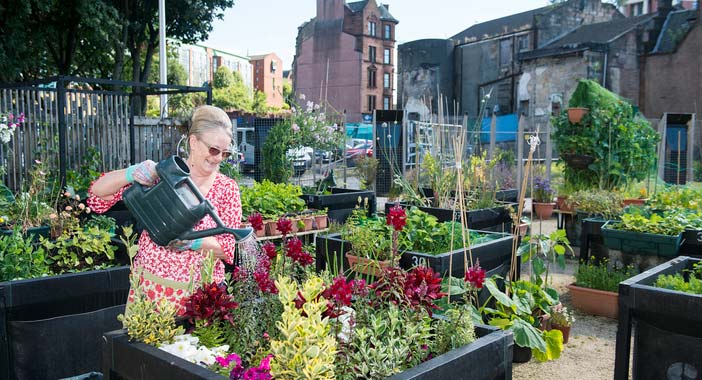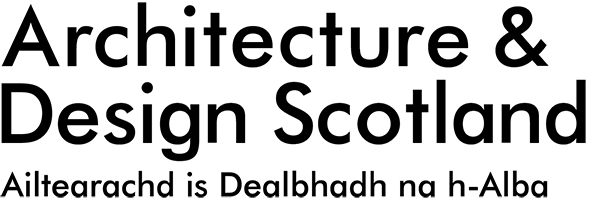From eyesores to empowered spaces: getting Stalled Spaces off the ground

To support our focus on community and learning from Stalled Spaces Scotland, Susan Mansfield talks to the people involved in getting the Stalled Spaces project off the ground.
CHOOSE any town or city in Scotland, it won’t take you very long to find stalled spaces: a gap site where a building has been demolished, or one earmarked for development which hasn’t yet begun. Overgrown with bushes, scattered with litter, it’s a space going nowhere fast.
Now, however, across the country, these vacant spaces are finding a new lease of life as community gardens and forest schools, art exhibition spaces and outdoor gyms, thanks to Stalled Spaces Scotland, a national project managed by Architecture and Design Scotland and supported by Commonwealth Games Legacy funding.
Whether it’s children exploring the outdoors in Clarkston, raised vegetable beds in Paisley’s West End, flower-cultivation in Forfar or a pop-up cinema next to the Clyde, spaces which were eyesores are becoming platforms for community empowerment.
“We all know about little bits of land in town centres which are never going to work for anything really, or if they are it will be a long time coming,” says David Cowan, head of the Scottish Government’s Regeneration Unit, who was involved in commissioning the programme. “Taking a place that nobody wants to go and doing something with it can have a massive impact on people’s confidence, well-being, their feelings about the place where they live.”
Cleaning up vacant sites
It’s now nearly a decade since a motion was brought before Glasgow City Council about cleaning up the vacant spaces in the city. Developments had stalled during the economic downturn, and the Council itself didn’t have the resources to maintain empty sites.
Launched in 2011, Glasgow City Council's Stalled Spaces programme was an innovative solution to a thorny problem: community groups were invited to present their own ideas, and in return were offered support with the planning and legal aspects, and the opportunity to bid for small grants.
Seamus Connolly, principal officer in City Centre regeneration, who helped launch the project, said:
“We were trying to tap into the residents who open their curtains in the morning and see a derelict site that’s covered in fly-tipping, or pass one on their way to work or when they take the kids to school, to ask them: what would you like to do in that area? If they came up with the idea, we would deal with the back-office stuff and let them concentrate on what they wanted to do on the site.”
In the first two years, 23 hectares of disused land across 59 sites were brought into community use (there are now over 100 active Stalled Spaces in Glasgow alone). From an initial funding pot of £88,000, groups brought in a further £500,000 of investment from other sources.
Glasgow City Council's Stalled Spaces was so successful that it was recognised with a range of awards, including winning the prestigious City to City Barcelona Fostering Art & Design (FAD) Award in 2013.
“I wasn’t surprised that there was such appetite for it in the city,” says Heather Claridge, senior project officer in Forward Planning Department. “It taps into the essence, the spirit, the creativity in the city. But I was quite surprised, when we went to visit some of the sites, how creative people were being. You don’t expect a brick pizza oven, or musicians performing, or children from a nursery school toasting marshmallows on a camp fire.”
Claridge and Connolly believe one of the reasons for the success of Stalled Spaces is that all parties involved understood from the outset that the project is temporary. Connolly says:
“We wanted to develop an initiative which protects the community groups who want to activate the spaces, but also to show landowners and developers that their end use was protected. Developers have paid millions of pounds for some of these sites and they want a return on their money, so a written agreement needed to be signed by both parties. Now, a number of sites in Glasgow have been returned to the developers and we’ve had no issues with placards or protests because everybody knew from the outset what the parameters were.”
Creating a national legacy
Following the success of Glasgow City Council's Stalled Spaces, the Scotland-wide project was rolled out in 2014 supported by Commonwealth Games Legacy funding and the Scottish Government’s Urban Regeneration Fund.
Architecture and Design Scotland worked with seven local authorities, using a model similar to the one developed by Glasgow City Council: community groups who came forward with ideas would be offered assistance with the bureaucratic process and the chance to apply for small amounts of funding.
Iain Cunningham, third sector development officer with Engage Renfrewshire, was one of those who helped implement the programme on a local level. He says he was sceptical at first:
“I did struggle with the concept initially. It seemed like we were asking groups to work through a lot of bureaucracy for what wasn’t a lot of money, and I wasn’t sure if it would work. But once we got things moving, my fears soon disappeared.”
He said that providing support through the planning process was essential, streamlining obstacles which might otherwise seem insurmountable.
“People needed to find out who owned the land and approach them. Once we told them we had support mechanisms in place for land searches and applications, and simplified the process of applying for funds, people bought into it straight away. We had so much interest, we had to start turning people away.”
One unusual site which has been transformed through Stalled Spaces in Renfrew is a disused public toilet block next to a bus stop at the entrance to Robertson Park. Renfrew Development Trust came up with an innovative proposal to build bridges across the generations: young people from Renfrew YMCA interviewed elderly people in local sheltered housing complexes to collect memories of the town, then partnered with students from West College Scotland to create storyboards for the walls of the building.
“It was meant to be there for three months, and it’s still there,” Iain Cunningham says, “People are proud of it, it’s a really good piece of work. But it’s about more than just the building: the young people were fascinated by the stories the old people told, and they have links with the college now, so they feel more confident about applying for courses there.”
Starting small: thinking big
Some groups who have benefited from Stalled Spaces Scotland are thinking big. Oban Communities Trust are in the process of raising funds to turn a disused primary school into the Rockfield Centre, a cultural hub for the town.
Transforming the outside of the building with planters and flowers won’t finish the job, but it’s an important step along the way. Other projects were much smaller in scale, from a strip of land next to a railway embankment in Paisley just a metre wide, which is now a wild flower meadow.
All those who work on the project agree that involvement and transformation are more important than scale. Heather Claridge says:
“For me, if you have spaces doing nothing and you have community appetite to do something, even if its short-term it’s still worthwhile. Temporary activation of spaces is only one tool in the toolbox of regeneration, it isn’t going to solve all the issues. But even if it’s only for one night, the impact it can have is significant.”
We and our partners, hosted an event to share the learning from the Stalled Spaces Scotland programme on 10 May 2017 in Paisley Town Hall. The Seeding Success was free to attend and also see the launch of a Toolkit to encourage more people to get involved in their local spaces.
The Stalled Spaces toolkit
We developed the toolkit to provide you with detailed information and examples on how you can get started on a Stalled Spaces project—from creating your constituted group to promoting your project. You can access this toolkit and related case studies on our website by visiting our dedicated Stalled Spaces toolkit page.
